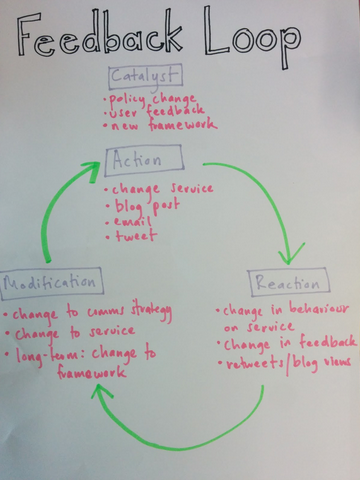In the Digital Marketplace team, we’re developing a measurement ecosystem for our service. By collating meaningful data from user research, website analytics, on-site feedback, helpdesk data, cost data and social media metrics, we’re able to understand user needs and develop our services and platform accordingly. When iterations are implemented, we then review the data to check whether our design decisions are working, starting the whole cycle again.
The idea of a feedback loop isn’t new or particularly complex, but it’s one of those things that’s great in theory and difficult to make a reality. Here are some of the obstacles to getting an aligned strategy up and running.
Influences on service usage
There are many factors that influence the traffic to a service, it’s hard to proactively monitor all of them. These factors can include; policy updates, seasonal demand, traffic from other websites and mysterious problems such as websites falling in Google rankings for no apparent reason.
Data overload
There’s a lot of data available; hundreds of reports in Google Analytics alone. So little of that data actually gives actionable insight into user behaviour. A lot of time can be wasted paying attention to interesting data that won’t result in any improvement to the service. I spent a long time creating analytics segments that identified how people started their visit, only to realise that this wasn’t as useful as monitoring the types of navigation (e.g. search, browse, filter) that people used throughout their journey.
Contextual factors
Within every team there are different skill sets, disciplines and internal processes involved. The perfect data strategy designed with faultless theory, could be completely unworkable within its context. For example, research might suggest that sales data should be your main success measure, but if it’s managed off-site and has a delayed reporting cycle it won’t give you insight that’s responsive enough for your day-to-day operations.
Four elements of success
We’re currently working through four stages to get a comprehensive feedback loop:
1.Consistent cross channel communication
Communications via social media, blog posts and emails are strategically planned to ensure the right message is going to the right audience at the right time. We also ensure that communications are consistent across all channels.
2. Monitoring user engagement
We can see how successful each message and channel was by monitoring the user behaviour in relation to that message. We might monitor how many people clicked through from a blog post to the Digital Marketplace service for example.
3. Long-term monitoring
By recording the success of different messages and channels we learn more about our audience and how we can reach them most effectively.
4. User insight driving service design and communication strategy
We proactively track the most insightful data and use it to improve the way we communicate and the Digital Marketplace service.
We will continue to monitor, measure and record this data to inform future improvements to the service. Over time we will see more significant trends emerging that we’ll continue to feedback to our development team. This continuous cycle ensures we always put user needs first.
